Dmitry Mouromtsev
Zero-Shot Cross-Lingual Transfer in Legal Domain Using Transformer Models
Dec 11, 2021



Abstract:Zero-shot cross-lingual transfer is an important feature in modern NLP models and architectures to support low-resource languages. In this work, We study zero-shot cross-lingual transfer from English to French and German under Multi-Label Text Classification, where we train a classifier using English training set, and we test using French and German test sets. We extend EURLEX57K dataset, the English dataset for topic classification of legal documents, with French and German official translation. We investigate the effect of using some training techniques, namely Gradual Unfreezing and Language Model finetuning, on the quality of zero-shot cross-lingual transfer. We find that Language model finetuning of multi-lingual pre-trained model (M-DistilBERT, M-BERT) leads to 32.0-34.94%, 76.15-87.54% relative improvement on French and German test sets correspondingly. Also, Gradual unfreezing of pre-trained model's layers during training results in relative improvement of 38-45% for French and 58-70% for German. Compared to training a model in Joint Training scheme using English, French and German training sets, zero-shot BERT-based classification model reaches 86% of the performance achieved by jointly-trained BERT-based classification model.
Russian Natural Language Generation: Creation of a Language Modelling Dataset and Evaluation with Modern Neural Architectures
May 05, 2020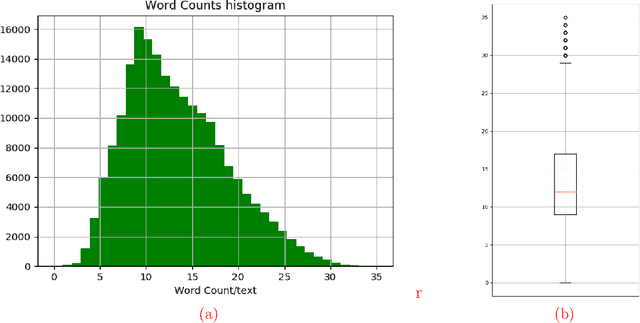


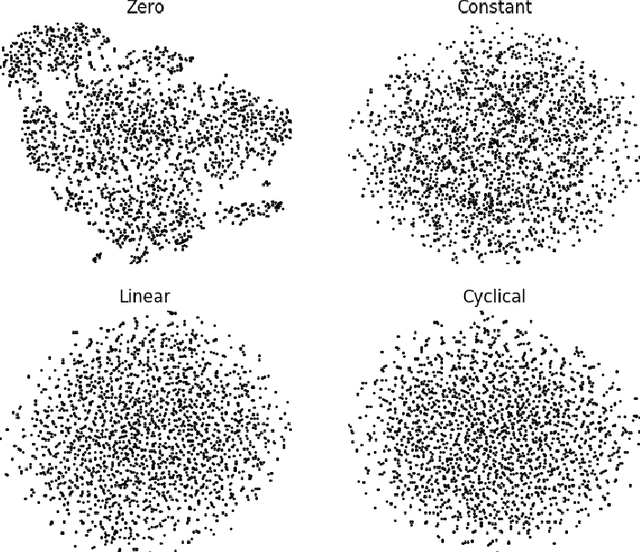
Abstract:Generating coherent, grammatically correct, and meaningful text is very challenging, however, it is crucial to many modern NLP systems. So far, research has mostly focused on English language, for other languages both standardized datasets, as well as experiments with state-of-the-art models, are rare. In this work, we i) provide a novel reference dataset for Russian language modeling, ii) experiment with popular modern methods for text generation, namely variational autoencoders, and generative adversarial networks, which we trained on the new dataset. We evaluate the generated text regarding metrics such as perplexity, grammatical correctness and lexical diversity.
A Comparative Evaluation of Visual and Natural Language Question Answering Over Linked Data
Jul 19, 2019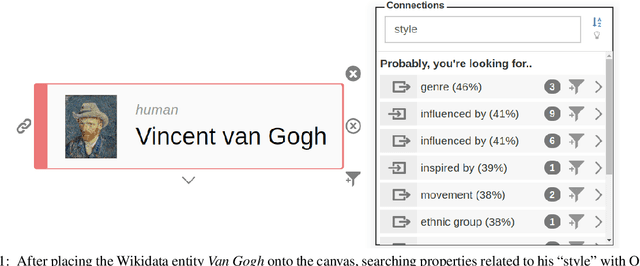


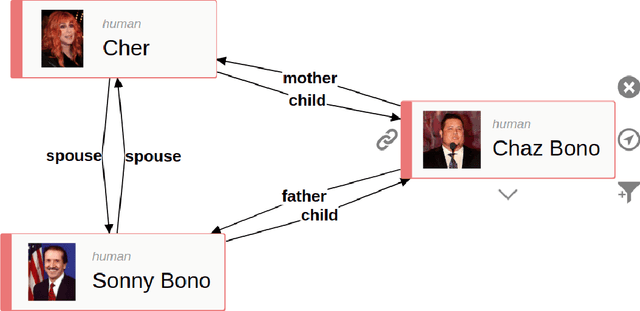
Abstract:With the growing number and size of Linked Data datasets, it is crucial to make the data accessible and useful for users without knowledge of formal query languages. Two approaches towards this goal are knowledge graph visualization and natural language interfaces. Here, we investigate specifically question answering (QA) over Linked Data by comparing a diagrammatic visual approach with existing natural language-based systems. Given a QA benchmark (QALD7), we evaluate a visual method which is based on iteratively creating diagrams until the answer is found, against four QA systems that have natural language queries as input. Besides other benefits, the visual approach provides higher performance, but also requires more manual input. The results indicate that the methods can be used complementary, and that such a combination has a large positive impact on QA performance, and also facilitates additional features such as data exploration.
Relation Extraction Datasets in the Digital Humanities Domain and their Evaluation with Word Embeddings
Mar 04, 2019
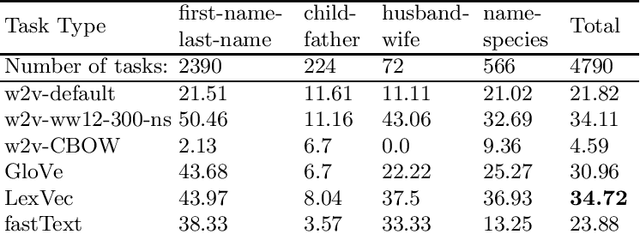
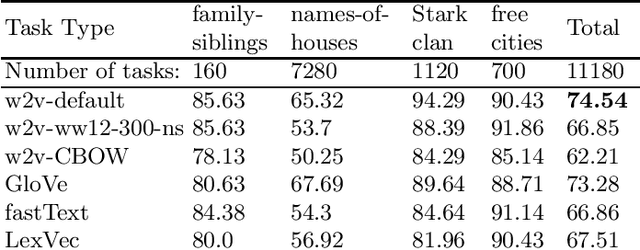
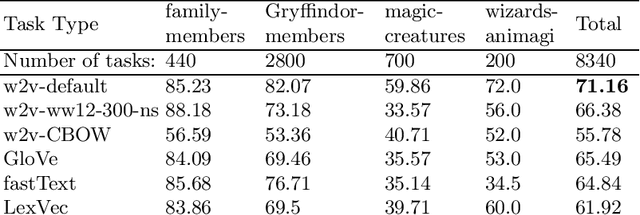
Abstract:In this research, we manually create high-quality datasets in the digital humanities domain for the evaluation of language models, specifically word embedding models. The first step comprises the creation of unigram and n-gram datasets for two fantasy novel book series for two task types each, analogy and doesn't-match. This is followed by the training of models on the two book series with various popular word embedding model types such as word2vec, GloVe, fastText, or LexVec. Finally, we evaluate the suitability of word embedding models for such specific relation extraction tasks in a situation of comparably small corpus sizes. In the evaluations, we also investigate and analyze particular aspects such as the impact of corpus term frequencies and task difficulty on accuracy. The datasets, and the underlying system and word embedding models are available on github and can be easily extended with new datasets and tasks, be used to reproduce the presented results, or be transferred to other domains.
Using Word Embeddings for Visual Data Exploration with Ontodia and Wikidata
Mar 04, 2019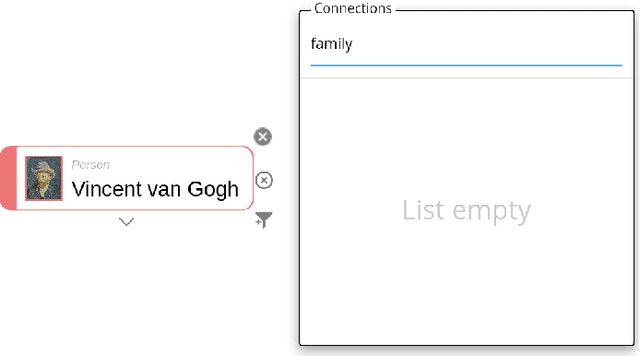
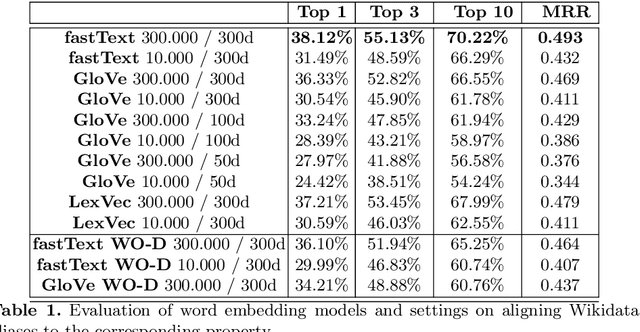
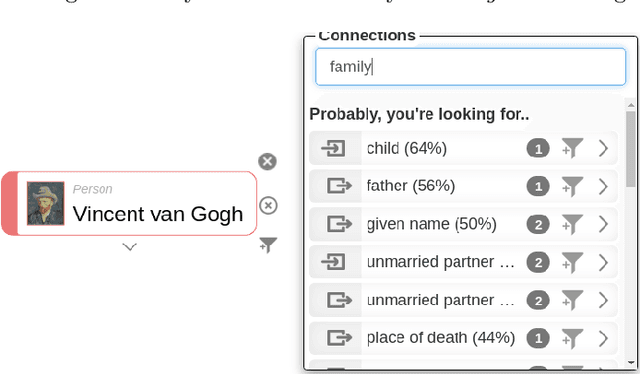

Abstract:One of the big challenges in Linked Data consumption is to create visual and natural language interfaces to the data usable for non-technical users. Ontodia provides support for diagrammatic data exploration, showcased in this publication in combination with the Wikidata dataset. We present improvements to the natural language interface regarding exploring and querying Linked Data entities. The method uses models of distributional semantics to find and rank entity properties related to user input in Ontodia. Various word embedding types and model settings are evaluated, and the results show that user experience in visual data exploration benefits from the proposed approach.
 Add to Chrome
Add to Chrome Add to Firefox
Add to Firefox Add to Edge
Add to Edge